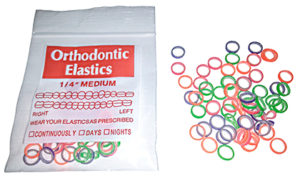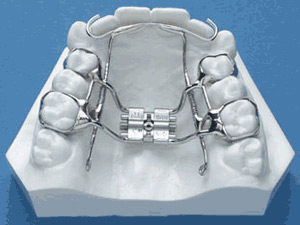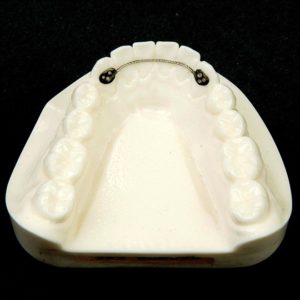Nance Holding Arch
Two molars bands are wrapped around the back teeth and connected by metal bands in the middle of the palate with an acrylic button. It is often used when the baby teeth have fallen out too soon, meaning that the first molars need support so that way they will not come forwards.
When wearing a Nance Holding Arch, stay away from sticky food which can pull it apart. Make sure to brush it and keep it clean.
Elastics
Elastics, or rubber bands, are used to move individual teeth and/or align patients’ jaws correctly. As this force must remain constant for good results, elastics need to be worn full-time, even when eating. They should be changed daily.
There are a number of different ways rubber bands can be worn, depending on which teeth need to be moved. They can be attached to the teeth via individual hooks or may be hooked onto the braces. Since the rubber bands are only supposed to move teeth, if you feel any pain or discomfort in your jaw, you should immediately let us know.

Biteplane
Made of acrylic and wire, the Biteplane reduces deep overbites by stopping patients from biting down completely on their back teeth. This lets their back teeth erupt naturally, which in turn reduces the overlap of the front teeth.
The Biteplane should be worn all the time other than eating or brushing, and should be kept clean by daily brushing.
Utility Arch
Often it is necessary to correct the overbite before placing braces on all teeth. Utility arches begin the process of aligning the teeth. In a few cases, the two orthodontics appliances may be used together.
Separators
Separators are little rings placed between the teeth in order to separate them. This allows for band placement on the molars. They may feel uncomfortable, but we assure you that they are necessary. Please avoid sticky foods, floss, and toothpicks to prevent them from falling out. If they do fall out, contact us so that way we can tell if they need to be replaced.

Separators
A type of expander, it works to widen the front of the mouth without widening the back. It works by placing metal bands on six molars which are then connected to the center, where there is an expansion screw. In this case, younger patients will see more rapid and more stable results.
Turbo Brackets
Turbo Brackets are a more severe form of Biteplane. They prevent patients from biting completely down on their back teeth, reducing the overlap of the front teeth. Unlike the Biteplane, Turbo Brackets cannot be removed. This can make eating difficult at first, so we recommend eating soft foods during the transition process. Expect the back teeth to come back together over a few months.

Palatal Expander
The Palatal Expander expands the upper dental arch in order to fix crowding and correct crossbites. The center screw is connected to the molars by a metal bar and then a band around the molars. The appliance not only moves the teeth apart, but actually moves pushes the palate bones apart.
Younger patients will see more rapid and more stable results. Once a patient gets old enough (approximately 18 for boys and 16 for girls), the two bones of the upper jaw fuse and expanding them usually requires surgery.
Forsus Springs
Forsus Springs are used to correct the fit of the upper teeth with the bottom teeth. They are usually used when rubber bands or Headgear does not work for a patient, usually when the patient refuses to wear them. However, they are not a true substitute for Headgear, and rubber bands are often preferable because they are more comfortable and make brushing easier.
Forsus Springs are extremely effective because they cannot be removed, therefore insuring a constant force on the teeth. They may also prevent the need for jaw surgery.
Fixed Lingual Retainer
They are a type of retainer where wires are bonded just behind the upper and/or lower front teeth. In the case where it is worn on the bottom front teeth, it is to stabilize them during the retention phase, and should remain in place for at least two years. When it is worn on the upper front teeth, it is usually because the patient had a significant gap between their two front teeth before treatment. In this case, it should remain for as long as is feasible, or until a dentist calls for its removal.


Headgear
This appliance is used when the lower and upper jaws have a difference in growth, causing the upper jaw to be too far forward of the lower jaw. Although it is primarily used to correct this difference, it can also be used during space closure to stop the upper back molars from slipping forward in patients who have had tooth extractions. Unlike most orthodontics appliances, this one uses the back of the neck and head as an anchor. It attaches to the teeth with a facebow or metal hooks.
Bitesplint
Bitesplints are rubber mouthpieces which are worn on the lower teeth in order to help correct a crossbite (a condition where the upper teeth are inside of the lower teeth) and is used with upper braces. It keeps the patient from biting all the way down, allowing for the teeth to be moved into the proper placement. The Bitesplint should be worn all the time, except for eating and brushing, and must be cleaned at least once a day.
